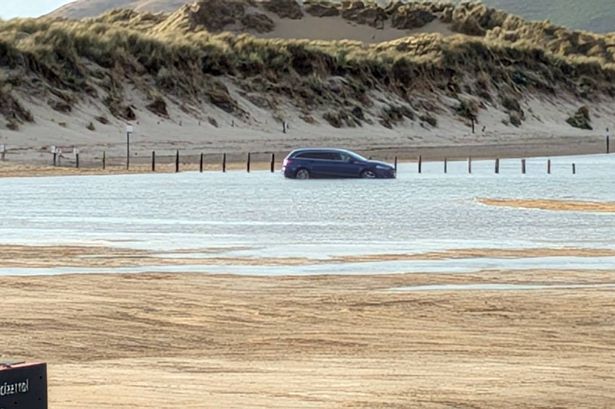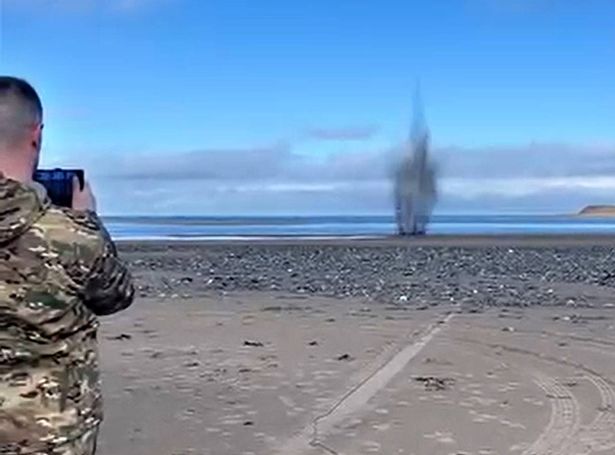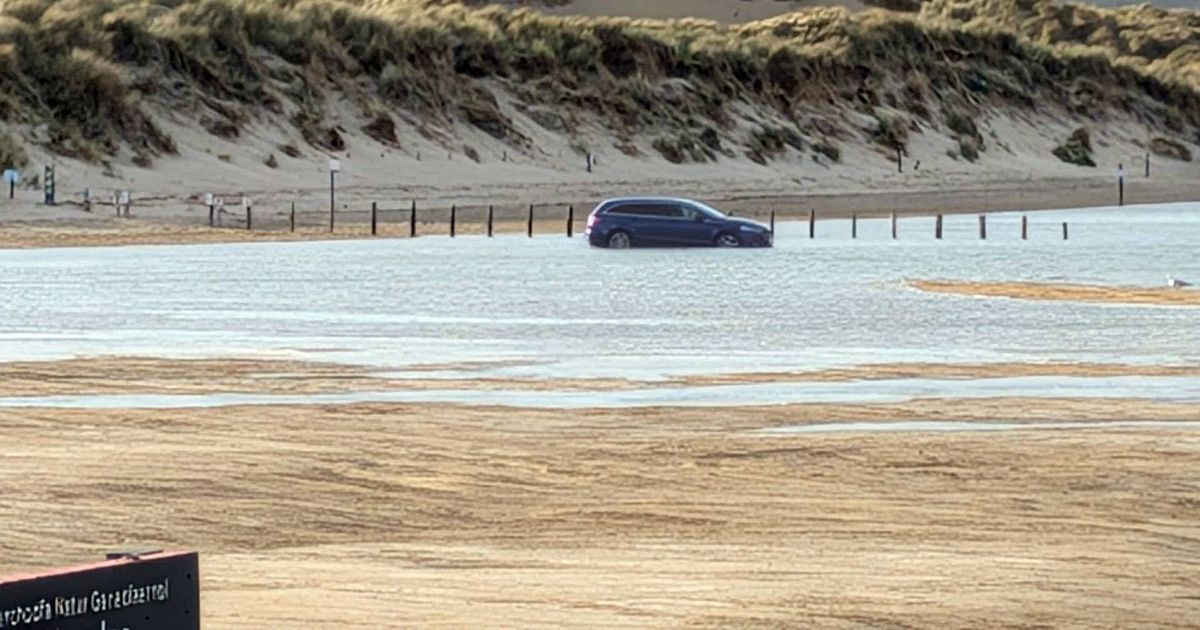The beach is notorious for fast-rising tides, with a car almost becoming entirely submerged A car caught out by the rising tide at Traeth Ynyslas beach
A car caught out by the rising tide at Traeth Ynyslas beach
A driver had a narrow escape when his car was surrounded by the sea at one of Wales’ most treacherous beaches. Spectators could only watch as the silver Ford Mondeo estate was gradually devoured by a powerful five-metre tide at Traeth Ynyslas, on the windswept west coast of Ceredigion.
Shouts rang out for the owner, while others frantically searched for a towing rope. A few contemplated whether they should intervene by breaking the car’s windows so it could be pushed to safety.
“A window is cheaper than a whole car,” said one.
Just in time, the driver returned, wading out to the vehicle in the hope it would restart. To everyone’s relief, the car churned up the water as it reversed rapidly to dry land.
In addition to fast-rising tides, the beach is infamous for its unexploded ordnance, a remnant of the area’s use as a test range for rocket-propelled explosives during and after World War II.
Just a few days later a controlled detonation was carried out by the Army’s Explosive Ordnance Disposal Unit, reports North Wales Live.
Beachgoers were once again warned not to touch any items on the beach that might resemble old bombs or shells. Read the biggest stories in Wales first by signing up to our daily newsletter here
Both incidents have been highlighted by locals campaigning against the closure of the visitor centre at Ynyslas Nature Reserve, just south of the Dyfi Estuary.
On April 1, its cafes and shops were closed by Natural Resources Wales (NRW), along with those at Coed y Brenin near Dolgellau and Bwlch Nant yr Arian.
Campaigners in Ynyslas are raising the alarm over the loss of staff at a popular site, which they say is putting both wildlife and public safety at risk.
The site, which draws 225,000 visitors annually, has seen changes after two full-time wardens were reassigned and four seasonal wardens lost their jobs, including Helen Heron, 56, from Borth.
 Controlled explosions of old military ordnance are not uncommon on the beach(Image: HM Coastguard Borth)
Controlled explosions of old military ordnance are not uncommon on the beach(Image: HM Coastguard Borth)
She argued that the team’s role extended far beyond just serving coffee, as they also managed the reserve’s wildlife and monitored visitor safety.
Heron claimed that incidents like the recent near-loss of a car on the beach would not have occurred under the old system. Before the wardens were replaced and the beach’s parking contract was privatised, visitors were verbally advised on safe parking spots and tide times.
“We would have warned them where not to park on the beach, telling them not to drive past its ‘gravel path’,” she explained. “As far as I know, the new gate men are not doing that.”
“The old NRW truck we used had a set of grip mats in the back. The two senior wardens, Andrea and Hannah, were trained in getting stuck vehicles away from danger.”
Natural Resources Wales (NRW) has justified the staffing cuts as part of an effort to save £12m across the board. Despite the changes, paths, trails, and other facilities at the three sites remain open, and NRW insists that wildlife protection continues under the supervision of land management staff.
Visitors have been reminded by authorities that they are “responsible for their own safety”, and this includes taking care of children and pets.
In May, a damning report from the Senedd’s Climate Change, Environment and Infrastructure Committee gave Natural Resources Wales (NRW) a firm three-month deadline to devise a “credible plan” for the shuttered visitor centres. The committee chair, Llyr Gruffydd, didn’t mince his words when he described NRW’s decision to close its doors as an “abandonment of public trust”.
Following discussions with NRW, campaigners for Ynyslas were informed that there are no commercial intentions for reopening the Ynyslas visitor centre. Instead, a “community use” approach is being considered – a stark contrast to Coed-y-Brenin and Bwlch Nant yr Arian, which are leaning towards commercial ventures.
NRW has confirmed to North Wales Live that their stance on Ynyslas has not shifted.
Being part of the treasured Dyfi National Nature Reserve, Ynyslas holds unique legal protections. The location isn’t just critical for safeguarding the ringed plover, a species under protection; it also boasts a beach classified as red-flag due to the perilous nature of its tidal currents.
Regulations are strict here: swimming or using inflatables is prohibited, boats are not allowed to launch, and digging within the dunes is forbidden. Furthermore, the beach car park is prone to flooding and the potential hazard of unexploded ordnance calls for heightened vigilance.
Polly Ernest, a spokesperson for Save Our Centre Ynyslas, expressed her concerns, stating: “The six wardens performed a range of functions, rotating around the site to protect the plovers, collect parking money, advise visitors and so on. Catering was just a tiny part of their work – it consisted only of a coffee machine and a few bought-in sandwiches.
“Now we have two guys sat at the gate taking parking money and issuing out-of-date leaflets. If the old wardens had still been around when the car was threatened by the tide, they would have run around and made sure they found the driver.
“In reality, they wouldn’t have let it happen in the first place. They would have advised on tide times and ensured the driver didn’t park where they did.
“One NRW staff member is still on site but 60% of their time is spend looking after the plovers. They can’t possibly provide the same public service that the six wardens previously offered. It’s an utter disaster waiting to happen.”
Efforts to mitigate risks have been taken, with the RNLI and Ceredigion Council erecting beach safety signs and providing life rings; a large red warning sign is displayed during periods of high tide, cautioning visitors about potential flooding that occurs between 15 and 21 days per month. NRW’s safety assessment categorised warden interactions with the public as “critical”.
A spokesperson for the environmental body noted: “We understand how important our sites are to local communities and visitors. We want to reiterate and reassure the public that all our sites remain open. This includes the paths, trails, car parks, play areas and toilet facilities, and the important work undertaken to protect wildlife and maintain these sites continues to be overseen by our land management staff.
“Visitors to all our sites, including Ynyslas, are responsible for their own safety as well as the safety of any children and animals with them during their visit. We would like to remind visitors that the car park is on the beach, and floods during high tides. Anyone parking there does so at their own risk and that has always been the case.
“The same systems remain in place for beach safety with signage and red flags across the site and personnel on the gate to the car park handing out information via leaflets to motorists which includes safety messages. Additional signage is also in place at the car park entrance indicating if a high tide is due and for how long the car park will be flooded.”
